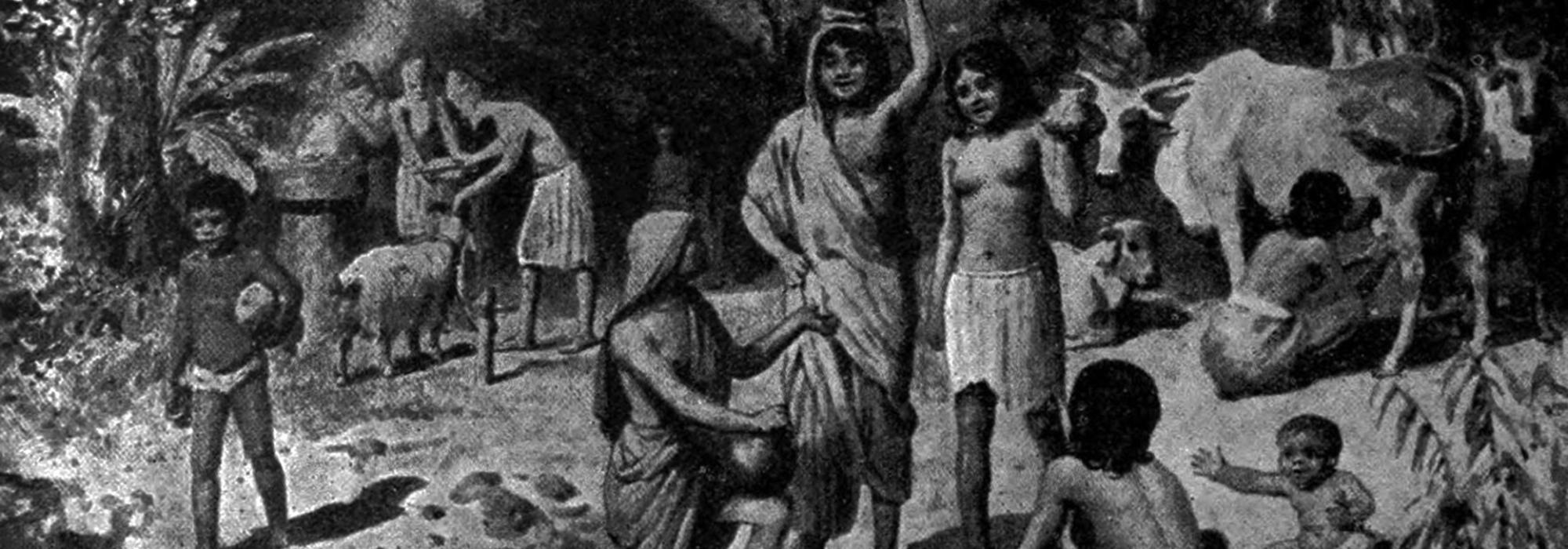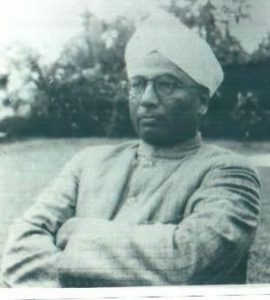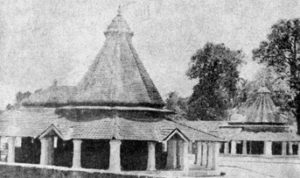Vedic traditionalists or Vedics in short, are a community of people who are fast fading into the pages of history. They are the torchbearers of Vedic traditions and have been carrying it forward for generations. A happy, contented life even under poverty has been a trademark of their way of life. Some of their traits include:
- Undeterred faith towards Vedas.
- Purity in every aspect of life.
- A simple lifestyle.
- Happy, contented life.
- Keen interest in teaching Vedas in the traditional manner.
When Christian missionaries arrived to India with an eye on conversion, they realized that the community of Vedics was the first one to attack if they had to succeed in breaking the faith rooted firmly in the minds of people. In fact, the very lifestyle of Vedics inspired people to have faith in our tradition. The missionaries began labeling these people as 'superstitious' and 'perpetrators of evil priest-craft.' Our own intelligentsia followed this blindly and began neglecting this class of people.
The great writer and polymath D V Gundappa dedicates an entire volume (out of eight) of his ಜ್ಞಾಪಕ ಚಿತ್ರಶಾಲೆ ('The Art Gallery of Memories') to the fond memories of his interaction with Vedics. When we reach the end of the book, we feel that their contribution to the steadiness and order of our society has been immense. I wish to narrate a few events from DVG's book.
The book starts with a vivid recollection of Punyashloka Venkatarama Bhat who was a Vedic living next to DVG’s house. His father’s name was Annam Bhat. Annapurnamma and Ammannamma were his sisters. What is this 'ಅನ್ನಂ' in these names? Annam means 'boiled rice.' This family was well-known for 'ಅನ್ನ ದಾನಂ' (munificence in serving rice to the needy). At any give time, four to five students would stay in their house and were engaged in the pursuit of subjects like Prayoga, Jyothisha, Dharmashastra, and Sanskrit. Every day, these students would visit temples nearby to look for brahmanas and would invite them to dinner; at least two or three such visitors would dine at their place daily. (In Indian culture, the practice of annadanam was considered one of the noble ways to practice charity. Till this day, many temples serve free food to everyone who visits it).
If we see the daily routine of this gentleman, he would spend around five to six hours in studying and teaching. In the evening, many people from every stratum of society (including harijans), would gather at his house, seeking his suggestions for their plans and problems. A few wanted to share and to seek solutions for their miseries, others wanted to decide time for auspicious events. He would listen to everyone’s concerns with utmost patience. For troubled minds, he would narrate a story, may be from Ramayana, Mahabharata, or from other sources which would soothe them, aiding them to steady themselves. DVG aptly comments that it is rare to have people who can give peace of mind to the troubled ones.
Shivashankar Shastri is another Vedic mentioned in the book. He used to join the rituals that took place in DVG’s house. DVG observes that he would wear busty clothes and was least conscious about it. If asked why not weave them at least, he had a ready answer. “How come a brahmana can wear a woven cloth? That is against tradition!” There was not a trace of humiliation or disgrace, but a sense of duty prevailing.
DVG recalls an incident about Venkatanarana Bhat that happened when DVG was an adolescent. In those days, four of DVG's father's friends were staying at his place. One evening, when DVG was about to go to bed, Venkatanarana Bhat came to their house and told Sheshappa (one of his father’s friends) that preparations had been done and he had to come at 9. Out of curiosity, DVG asked “What is it?” “Rasayana!” was the hurried response. Typically, 'rasayana' refers to a juicy liquid. But the word 'rasa' also means 'charming,' 'full of feeling,' 'art experience,' etc.
After a brief nap, when DVG opened his eyes, nobody were to be seen. “Rasayana,” he remembered and rushed to Venkatanarana Bhat’s house at once. There, four candles were lit, with a lively fragrance, and the environment was brilliant. Sheshappa was narrating a portion from Allasani Peddana's Manu Charitre (A work of poetry in Telugu). DVG got confused. "Where is the rasayana?" he asked. They laughed and told him, “What other rasayana can be better than this?” They were referring to the ಕಾವ್ಯ ರಸಾಯನ (beauty of poetry).
DVG says that it was only after several years that he got the essence of the incident. It was a night of a lunar eclipse that began at 9 pm and ended at 11. Tradition dictates that at the end of eclipse, brahmanas must take a bath and have to pray for the welfare of everyone. What to do till 11? That was the reason behind the kavya rasayana. Today we have electricity and several other facilities but how many of us spend a night reading poetry?Krishnam Bhat was the only brahmachari (unmarried and devoted to acquiring knowledge) Vedic about whom DVG mentions in his book. Krishnam used to come home at 10 or 11 in the morning after finishing all rituals. He would then take a cold water bath and worship the family deities in an elaborate manner. After lunch, he used to go to Venkataram Bhat’s house for discussions and then would visit other households for ಪಂಚಾಂಗಶ್ರವಣಂ (a tradition related to astrology). He would return home by evening, offer his prayers to the sun, and then visit the temple. He would sleep in the temple premises itself without eating dinner. “As much as possible, stay away from home, but do not forget duties for those who depended on you” – this was his principle. The Bhagavad-Gita (5.10) compares this attitude to 'ಪದ್ಮಪತ್ರಮಿವಾಂಭಸಾ' (like a lotus-leaf and water).
The young DVG faced tough times. His teacher Kashi Raghavendrachar asked him to come prepared with 35 ಧಾತುಪಾಠ (list of word roots arranged according to Panini's grammatical system) after his summer holidays. Time runs faster during holidays and just a week before the class, it started haunting him. He opened the book and started reading. But no, everything seemed to be vaporizing. He wept. At that time his grandmother came to his help. After understanding his problem, she asked him to bring the book. “Oh dear! This is so small, in fact, this can be measured by a single finger. 35 is nothing. Within a day, you can finish more kodubales (rice crispy rings) than this. One page is not even comparable to one kodubale. What kind of man are you to weep for this?” This proved to be a confidence booster and without any fear, DVG focused on his studies.
As an illustration to the kindheartedness and the courtesy among Vedics, DVG recollects an incident that had happened between Kunigal Rama Shastri and Mannaragudi Raju Shastri. By then, Raju Shastri was honored everywhere for his traditional knowledge. He was aged and was teaching many students, taking care of their all needs. Rama Shastri, a young and well-known scholar, was going to Rameshwaram along with his close associates and students in a 'mene' (A single-seater, carried by four people at four corners). When this journey was passing through a location where Raju Shastri was staying, Raju Shastri also joined the followers but did not disturb any of them. This continued for two full days and Raju Shastri’s students were feeling uncomfortable. “Our master is a scholar and an elderly man. This Rama Shastri fellow seems to be arrogant. He neither talked to our master nor offered his a seat in the mene.” Raju Shastri told them with a smile, “See, the person travelling here is a great scholar. May be he did not observe us following him. Wait couple of days, you will realize his greatness. He is an expert in 'ನವೀನ-ನ್ಯಾಯ' (modern Logic) where as I know only of 'ಪ್ರಾಚೀನ-ನ್ಯಾಯ' (traditional Logic). At my age, I can’t travel to far-away lands to learn these new innovations. I'm following him to acquire this knowledge. Be patient. There is nothing demeaning in it.” The next day, Rama Shastri observed Raju Shastri following the mene. He asked, “Sir, who are you?” Raju Shastri introduced himself and told his intentions. Immediately, Rama Shastri got down from the mene and held Raju Shastri's legs in respect. Then Rama Shastri forced Raju Shastri to sit in the mene and they continued their scholarly discussion throughout the journey. This was the way of scholars in the olden times.
DVG wanted to learn the bhasyas (traditional commentaries on important works) under Tipparu Virupaksha Shastri, known for his erudition and devotion in tradition. On the first day, DVG went to his house with fruits, flowers, and a small amount of money. Virupaksha Shastri was offering prayers to god. He welcomed DVG and took the fruit and flowers. He said, “Why is money kept here?”
"Oh, it’s a small amount."
“No tradition of taking money, please take it back.”
“Once given, tradition does not permit me to take back as well!”
Virupaksha Shastri smiled. He then called his student and told him to distribute the money to brahmanas in the pathashala.
Virupaksha Shastri had a great grip on the oral tradition. Every system of learning was at the tip of his tongue. He used to teach his students during taking bath and during lunch. He had less regard for printed knowledge. What then was the source of his knowledge? For this, we need to peek into Shastri's student days. He used to stay in a rented room. Electricity was yet to penetrate households at that time. In the night, he would light a lamp and would open a ತಾಳೆಯೋಲೆ book. These were handwritten ones, and each page would have eight to ten lines. He would read each of those lines two to three times. By this time, he would have committed them to memory. He would then turn off the lamp, go for a short walk during which he would grasp and memorize those lines, thus mastering them. Then he would return to his room, light the lamp with a ನಂದದೀಪ, and go to the next page. This was the arrangement to save oil and matchsticks.
Though he rarely used printed books, he had great respect for them. Once during a lesson, DVG kept the book on ground. Shastri stopped teaching. He said, “Please hold the book in your hands. Or place it on a desk. If book is kept on ground, the teaching will stop!”
Virupaksha Shastri used to visit Sringeri and Kaladi (Shankara's birthplace) once a year. DVG would request the railway police officer K Srinivasan for a specific favor. Srinivasan would inform the Arasikere station master. At 6 in the morning, the train would reach Arasikere. A worker would come to Shastri’s berth. Shastri would follow him to the nearest well. There, a tumbler and a rope would be arranged. Shastri would draw water from the well, clean everything around, and offer his morning prayers to the sun. This would happen in the evenings as well. For this arrangement, he would utter heaps of praise on everyone.
DVG, a great poet philosopher, introduced to his readers several such personalities from his memories. Their place in the society was unique. They were pure academicians in some sense but they were never got disconnected from the society. They fulfilled their duties towards the society and in turn, the society respected and took care of them. In contrast, few institutions today can survive without the patronage of government or NGOs or corporates. Pure academic institutes have lost contact with society and live in their own theoretical world where papers published in foreign journals are used as a yardstick for success. The teaching profession in general is largely funded by governments. The government is supposed to represent people and the society, but that still adds an additional level of hierarchy. Teachers have to look for government officials for their every need and there is a centralized failure point here, which is the government. Should the government become corrupt, all these systems weaken.
Journalism has a similar model to that of the above school. Newspaper economy depends on readership. A journalist, by her investigative journalism and strong ethics would try to raise the conscience of society and was well-respected by society and people. Even that is slowly getting corroded by greed and favoritism. When we look at society from this viewpoint, we should be grateful to this Vedic tradition, which placed itself in a respectable position in the society, tirelessly worked for the development and propagation of our culture, especially when there was no centralized support. We may feel odd at times about their extreme focus on discipline, purity, and selflessness, but these are the very virtues that attract confidence and love from society.
What drove these people to stick to these values for generations? This attitude was not peculiar to any community, but a common manodharma (mentality) of society itself. The driving force for this were rta- (universal order) and rna- (indebtedness) prajne (consciousness, awareness). When you respect the order in Creation and feel indebted for Creation and society, it is natural for a society to become duty-bound.
Mutual respect between the society and these people was the key to the survival of this culture. An uncle of mine told me about Mari Shastri, a Vedic from Barkur (in Udupi district). He trained his eldest son in the traditional way, while others followed modernity. Once at a family gathering, the eldest son was mocked by his relatives for his mode of dressing and his traditional ways. When he returned home, he decided to privately appear for the SSLC exam and presently he resides in the US. The unbroken family tradition ended in his generation.













































